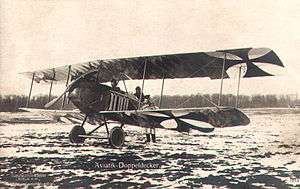Aviatik B.I
| B.I | |
|---|---|
 | |
| Aviatik B.I (P15 type) | |
| Role | Reconnaissance aircraft |
| Manufacturer | Aviatik |
| Designer | Robert Wild |
| First flight | 1914 |
| Introduction | 1914 |
| Retired | 1916 |
| Primary user | Luftstreitkräfte |
The Aviatik B.I is a German two-seat reconnaissance biplane designed and built by the Automobil und Aviatik AG company, who until then had produced copies of French designs.
Design and development
The first of indigenous Aviatik biplanes, designed by Robert Wild, was P13 type, flown in April–May 1912.[1] It was built in several variants and featured large 3½-bay or 4-bay wings and .[1] The type was widely used in competitions and gained high reputation. An improved design was P14 of 1913, with smaller 2½-bay wings and aerodynamic and structural refinements.[2] Also in 1913, an ultimate refined design P15 was built, with 2-bay or 3-bay wings and a fail fin.[3]
The German air force got interested in Aviatik aircraft and ordered 101 of P13 and P14 in 1913, then further orders followed.[3] The crew sat in open tandem cockpits with the observer in the front. Initially they were designated just as Aviatik B, with a service number and two last digits of a year (e.g. B.268/13). From September 1915 the aircraft P15 type were designated as B.I (P15b with 100 hp engine) or B.II (P15a with 120 hp engine).[4] There is a supposition, that earlier B-class 100 hp Aviatiks might have been designated B.I as well.[4] Aviatik B-class were unarmed, but in a course of the war, machine guns were sometimes used.
The B.I was manufactured in large numbers in Italy under licence by Società Aeronautica Meccanica Lombardia (SAML), which built 410 examples according to Aviatik's design.[5] The firm then put two modified versions of their own into production, as designed by Robert Wild.[5] The first of these, the SAML S.1 was powered by a Fiat A.12 engine and was armed with a Revelli machine gun for the observer.[6] The second version, the SAML S.2 was intended for the reconnaissance-bomber role and had a shorter wingspan, a fixed, forward-firing Revelli gun in addition to the one in the rear cockpit, and a bomb load of 40 kg (90 lb).[6] The 16 Squadriglie da Recognizione operated 660 S-1s and S-2s from 1917 onwards in Italy, Albania, and Macedonia.[6] Two SAML S.1 participated in the Revolution of 1922 in Paraguay in the government side. They survived the conflict and they were the first planes of the new Military Aviation School, along a single SVA-5, a SVA-10 and a SPAD S.20. One S.1 was destroyed in an accident in 1928 but the other survived as a trainer during the Chaco War.
The Aviatik B.114/14 was the first aircraft shot down with gunfire in aerial combat on October 5, 1914, by French Voisin III.[7]
Operators
- Turkish Air Force - Postwar, SAML Aviatik B.I .
Specifications (B.I)
General characteristics
- Crew: 2
- Length: 7.97 m (26 ft 2 in)
- Wingspan: 13.97 m (45 ft 10 in)
- Height: 3.3 m (10 ft 10 in)
- Gross weight: 1,088 kg (2,399 lb)
- Powerplant: × Mercedes D.I 6-cylinder liquid-cooled inline engine, 74.5 kW (99.9 hp)
Performance
- Maximum speed: 100 km/h (62 mph; 54 kn)
- Range: 400 km (249 mi; 216 nmi)
- Endurance: 4hrs
- Service ceiling: 5,000 m (16,000 ft) [8]
See also
Related lists
References
- Notes
- Bibliography
- Angelucci, Enzo. The Rand McNally Encyclopedia of Military Aircraft, 1914-1980. San Diego, California: The Military Press, 1983. ISBN 0-517-41021-4.
- Gunston, Bill. World Encyclopedia of Aircraft Manufacturers. Annapolis: Naval Institute Press, 1993. 1-55750-939-5.
- Jackson, Robert. The Encyclopedia of Military Aircraft. London: Paragon, 2002. ISBN 0-75258-130-9.
- Taylor, Michael J. H. Jane's Encyclopedia of Aviation. London: Studio Editions, 1989. ISBN 0-517-69186-8.
- Grosz, Peter M. Aviatik B-types. Berkhamsted: Albatros Productions, 2003. Windsock Datafile No.102. ISBN 0-948414-95-2.
External links
| Wikimedia Commons has media related to Aviatik B.I. |